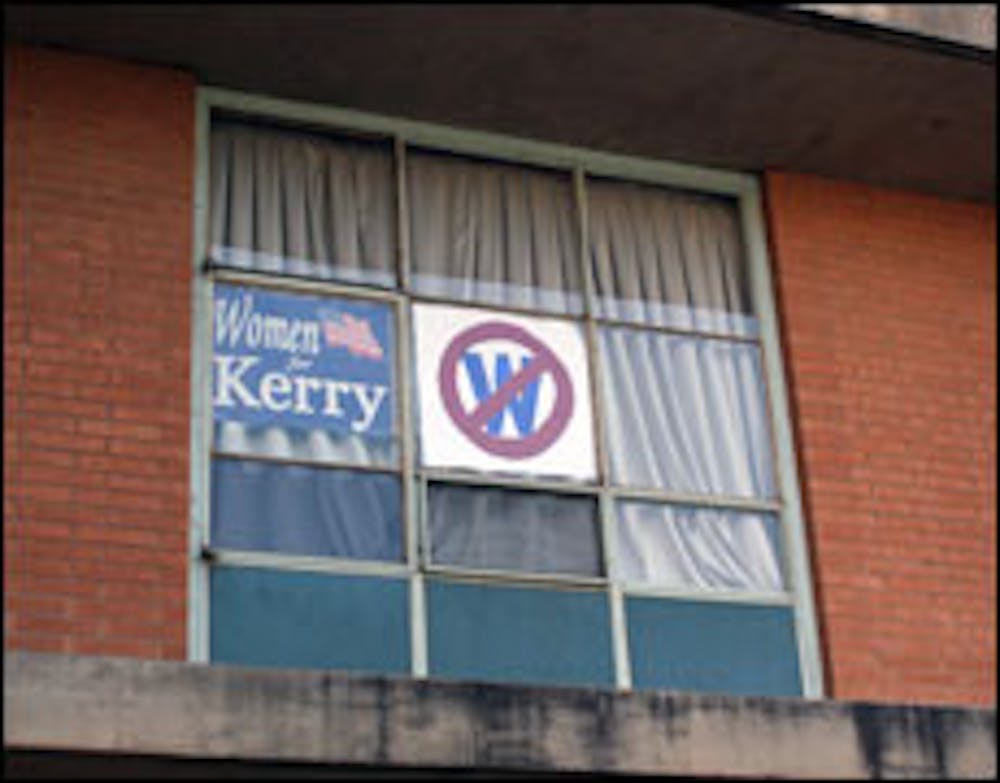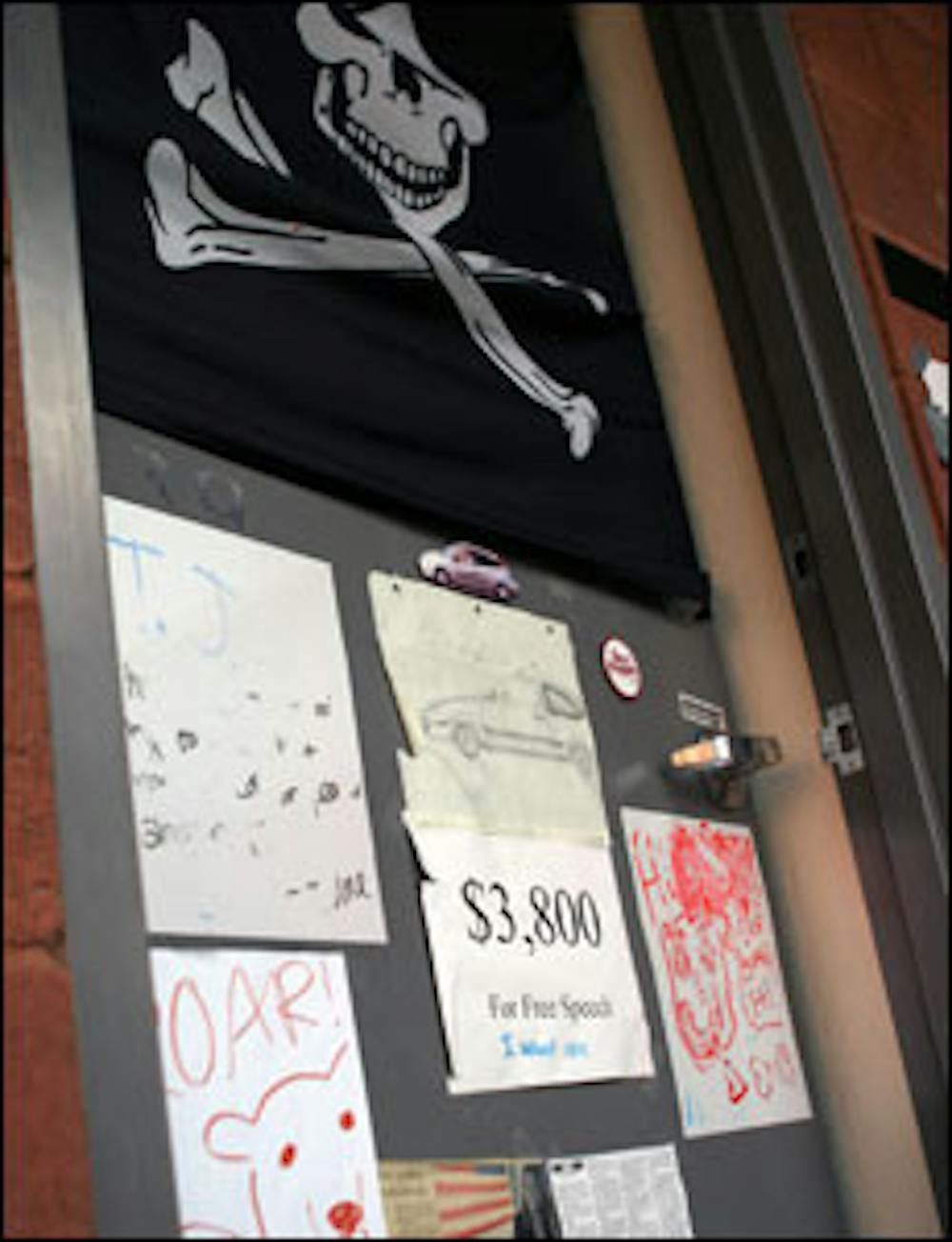A Residential Life policy currently bans a political campaign sign, a Mexican flag or even a picture of a best friend from being placed in a window, and students who want to display them must seek permission.
But this isn't the first time politics and free speech have collided on campus.
On several occasions, the University has taken issue with students' signs in residence hall spaces, some of which were considered racially charged or offensive, prompting battles between students and ASU.
This semester, the Oct. 13 presidential debate held at ASU and the election brought enforcement of the policy to light.
Students and officials from the Arizona office of the American Civil Liberties Union challenged the policy, stating they believe it is unconstitutional.
But ASU officials, Residence Hall Association members and some students have seen a need for the policy to protect students and the University from offensive speech.
Officials, students and experts alike agree that free speech on campus is anything but simple, and ASU has the history to show for it.
Complaints spark policy
The policy was developed beginning in 1998 when Residential Life officials received complaints about a message written across several windows in Manzanita Hall, according to director of Residential Life Kevin Cook.
Residential Life worked with the Residence Hall Association, a student group that lobbies for student interests with Residential Life, to create the policy in 1999.
The policy remained relatively dormant until a few weeks before the debate, when several students received citations for hanging political signs and other messages in windows in preparation for the debate and the presidential election.
Political science and history sophomore Laura Thorson asked the Arizona ACLU to investigate the policy.
Thorson received three citations from Residential Life staff, while her roommate, biology and society sophomore Hayley Ivins, received two citations.
RHA wrote a resolution to disagree with the policy at the request of Thorson and Ivins, but voted against it in an early October meeting.
RHA later approved a temporary break in the policy to display positive campaign materials between Oct. 21 and Nov. 4, to coincide with the election.
Then, Undergraduate Student Government officials passed a resolution disagreeing with the complete ban of all messages in windows in early November.
Currently, Residential Life officials are enforcing the window policy as it reads in the Residential Life Student Handbook, with one exception: Students may not display any messages in windows except an unaltered American flag.
Free speech battle
In the past, racial conflict has sparked free speech debate at ASU. It has continued up to some students' efforts to fight a controversial Residential Life window sign policy today.
Racial tension hit the University beginning in the late 1980s, prompting ASU to create the Campus Environment Team, said ASU law professor Paul Bender.
According to the Campus Environment Team, in April 1989, four black students were injured in a brawl on fraternity row after they were mistakenly associated with a group involved in an assault and two of those students were taken into custody for disorderly conduct.
On-campus protests followed the fight and University officials responded by creating the team.
Former ASU President Lattie Coor and law professor Charles Calleros were two founders of the Campus Environment Team, an organization intended to protect freedom of speech at ASU while also combating intolerant and offensive speech through discussion and education.
Coor, now a member of Center for Arizona Futures, said he remembers being inaugurated in the midst of a national free speech controversy at ASU, when a student taped a racist statement to a dorm room door.
In 1991, the University received national media attention after a group of black female ASU students walked by an apartment in the Cholla residence hall, to find a racially charged flier taped to a door, Calleros said.
Calleros, who was an associate dean and professor in the law school at that time, said the flier looked like a job application, but included statements that implied that black people were inferior to white people.
The students contacted Residential Life, but asked for discussions about race relations rather than restrictions of ASU's speech policy, Calleros said.
Calleros, then president of the Campus Environment Team, said the team's goal was to discuss the speech that the students found offensive and get students to understand each other.
In June 1991, The Washington Post printed an editorial about the issue.
Coor said free speech is important on campus, even when people disagree. The Campus Environment Team was a revolutionary idea, Coor said.
"It was kind of a model to the rest of the nation in a time when speech codes were being enacted," Coor said.
Muddy waters
Calleros said the window policy is a more complex issue than the flier in Cholla because it concerns ASU administrators' ability to restrict speech on campus, rather than the issue of the right to display offensive speech.
Students have full free speech protection out in the open, but placing window signs in office or University space can be restricted to a greater degree, Calleros said.
But the amount of restriction that can be imposed is arguable, Calleros said.
"The University can say it's a place for its own speech," Calleros said. "But a dorm room is a very intimate context."
A person could argue that something posted in a window was not a student's opinion, but an opinion representative of the University, Calleros said.
ASU law professor Paul Bender said ASU's window policy isn't constitutional simply because the signs could potentially offend someone.
Bender served as the U.S. principal deputy solicitor general and argued on behalf of the United States in some cases in the Supreme Court in the mid-1990s. During that time, he helped the United States win a case that struck down the ability of Ladue, Mo., city officials to restrict the display of signs in residential windows.
Bender said the Constitution favors allowing people to hang signs and other information on their private property, and that he thinks the same right should extend to students in a residence hall.
"There may be more [legal] ability to stop it in a dormitory," Bender said. "But even if it's constitutional, that isn't a wise thing to do."
Bender said he didn't think the window policy sounded very constitutional because so much of the policy is left to the discretion of officials to decide if students must contact hall staff to display a sign.
"That's what constitutions are for -- to protect speech when a majority rules," Bender said. "You can't give officials that kind of discretion."
University speech
But the rule at ASU is muddier than that.
Anything attached to a University building is classified as University speech, said associate general counsel Nancy Tribbensee, who specializes in helping ASU develop its First Amendment policies.
Any message or sign attached to a University building becomes "University speech," Tribbensee said. Each building manager for every building on campus sets the standard for displaying messages in windows, and Residential Life officials determine what can be shown in dorm windows.
Tribbensee said the University could regulate its own property more than it can regulate "traditional public forum areas" like Hayden Lawn.
Tribbensee said ASU's rules don't prohibit people from speaking, but only from hanging signs.
"It's not the expression itself, it's the way it's being expressed," Tribbensee said.
Red flags
But Residential Life's policy restricts the messages that can be displayed in windows to everything except "unaltered American flags," Cook said.
The window policy underwent a review in 2002 to clarify some aspects of the policy that confused students, Cook said. All flags were specifically banned from windows by 2003, Cook said.
But Residential Life announced an exception to allow unaltered American flags a few weeks before the presidential debate.
The change in the policy appears unconstitutional, said ACLU staff attorney Angie Polizzi.
"A desecrated flag is a protected form of free speech, and it wouldn't be allowed [under the ASU policy]," Polizzi said.
Polizzi said constitutional case law indicates to her that students still retain rights to free speech.
"The students don't shed their rights just because they move into a dorm," Polizzi said. "I've never seen that in any constitutional case."
Polizzi said she is still working with ASU to discuss the policy and get more information about it.
Law professor Calleros said the flag clause raises questions about the constitutionality of the rule.
"I don't think it would make sense to say an American flag can go up but an item critical of the administration cannot," Calleros said.
A resident assistant, who asked not to be identified for fear of being fired, said Residential Life officials have given different instructions at different times about how to enforce the policy, and that discussion about it wasn't as strong in past years as it has been this year.
"I can tell you I didn't hear about it until this year," the RA said.
The RA said the policy has always existed, but the allowance of unaltered American flags had to be clarified later since it was not explicitly stated in the Residential Life Handbook.
"We were told right away that it would be national flags from anybody's nation," the RA said. "We were told two weeks afterward that it would be only unaltered American flags and they could cover only 50 percent of the window."
Some students' responses to the policy have been "a little overblown," the RA said.
But students should not be restricted to American flags only, the RA said.
"It's highly suspect because suddenly we're ignoring everyone else's heritage," the RA said.
Then and now
Fifteen years after the beginning of the free speech debate as ASU, students are still struggling with the policy.
Students who want to hang signs in their windows should try speaking with their hall council and hall coordinator first to obtain permission, Cook said.
Irish B RA Katy Chapman, an early childhood education senior, said she is in the process of making a request to the Center Complex hall staff to allow students in Center Complex to hang political signs that don't contain personal attacks against politicians or use expletives.
Chapman said she wanted students to have the ability to speak without breaking Residential Life's policies, and that she knows of other students who are trying to make similar requests.
"I think that in light of how our campus got so involved in politics, that we should be allowed to voice our opinions in our windows," Chapman said.
But Chapman said she made a request for a content-based sign standard because otherwise, no signs could be displayed at all.
"It's the only way I could pass it with hall council," Chapman said.
USG Barrett Honors College senator Jonathan Confer said USG officials would try to work with RHA and Residential Life to alter -- but not necessarily remove -- the policy.
Reach the reporter at nicole.saidi@asu.edu.






